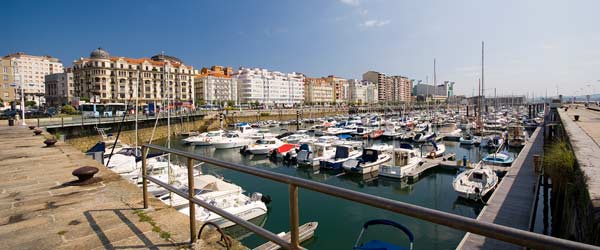Two days in Santander
Santander is without a doubt one of the most beautiful and elegant cities on the north coast of Spain. Both the sea and the mountains are continually present in this city, which, with its aristocratic atmosphere, its 19th-century buildings, its charming outdoor terraces and its spectacular bay, is considered to be one of the most beautiful in the world.
Day 1
Historic quarter
We begin our itinerary in the gardens of Pereda, where we can stop by the tourist office to pick up information. A walk through the gardens enjoying the sight of the cedar and magnolia trees brings us to the Historic Quarter. It is not very large, so the best way to explore it is to take a gentle walk through its streets, look at its monuments, and observe its elegant atmosphere. The first thing we notice is the majestic façades of its banks, of great importance in Santander. If we continue on down Calle Hernán Cortes, we reach the Plaza Porticada (porticoed square), one of the liveliest and most symbolic places in Santander, as it was built with the idea of making it the central hub of the city after it was devastated by fire in 1941.
Next door, we find the church of Cristo and the Santander Cathedral, opposite the church of La Compañía. Now is the moment to capture some of the beauty of our surroundings on camera and to learn something about the legends which tell of the origins of the city. If we continue along Calle Juan de Herrera, we come to the Plaza del Ayuntamiento square. There is always a lively atmosphere here, and there are sure to be groups of people relaxing on its benches.
From here, we can go on to the Municipal Fine Arts Museum or to the House-Museum and library of Menéndez Pelayo, one of the region's great thinkers. But if we're looking for a cheerful atmosphere and a chance to see the everyday life of Santander's inhabitants, what better than a visit to the Esperanza market, where they sell some of the best fresh fish in Spain?
After our morning of culture, we can take a little time off to make a few purchases. If we continue along the streets of Jesús de Monasterio and San Fernando, we find ourselves in the most commercial area of Santander, the ideal place to find a gift or a souvenir of our trip.
A city open to the sea
Right in this area, and particularly in Calle Vargas (parallel to San Fernando) there are several places that are perfect for sampling Santander's typical seafood cuisine. Don't forget to ask for the famous rabas (squid), sea snails or mussels. Delicious.
Afternoon is the ideal time to get to know maritime Santander, with a stroll beside the attractive area beside the dock. We leave the Pereda gardens, beside which stands the famous Stone Crane, weighing 30 tons.
We might want to enjoy a cup of coffee in Pereda avenue, as it is lined with charming and elegant literary-type venues. Just a few metres away is the Embarcadero Mansion, and this the departure point for a pleasant boat trip which takes us on a tour of the bay. There is an incredible view of the city from the sea, which makes this one-hour trip an unforgettable experience.
Once back on dry land we can take a walk along the Calderón dock until we reach the sculpture of “Los Raqueros” (harbour waifs) which depicts a group of children diving into the water, created in memory of the children who years ago used to dive into the bay to pick up the coins thrown to them by tourists. A photo beside it makes an interesting and original image.
If we continue on our walk we pass by the Puertochico Yacht Club, and past eye-catching buildings such as the Planetarium and the Festival Centre. A walk along Luis Carrero Blanco avenue brings us to the Maritime Museum, which is well worth a stop to see the modern aquariums inside, and where we can learn more about man's relationship with the sea. Once past the museum, we come to the beach area (the Los Peligros and La Magdalena beaches are first), where we can cool off and spend the rest of the afternoon.
Things to remember
There is a bicycle lane all along this route so you can do some sport while you enjoy the seascape.
The boat trips from the Embarcadero Mansion run between July and October, approximately.
At dinner time, a good option is to return to the centre and "go out for tapas" (going from one bar to another sampling small portions of the local specialities) in the area around the Plaza de Cañadío square. This is one of the best areas in the city if you feel like going clubbing or having a drink after dinner. If it's summer, you're bound to find the square full of people out having fun.
Day 2
Magdalena Peninsula
We're now going to spend the morning exploring the Magdalena peninsula, one of the most beautiful and attractive areas in Santander. Before arriving, we can go down Calle Horadada to the seashore and enjoy a beautiful view of the islands of La Torre and Horadada from beside the rocks. Now we go on until we come to the entrance to this great park. This is an extensive area of some 25 hectares, so if we don't feel like walking, we can always hop on the "Magdaleno" tourist train which runs all around the park.
This time though, we'll explore it on foot. We pass near the Los Bikinis beach until we come to the Embarcadero Real pier and then on to the La Cerda lighthouse. If we continue on around the peninsula, we reach an esplanade which takes us to Santander's greatest treasure: the Magdalena Palace.
We are now at the highest point of the peninsula, so this is the perfect time to take a photo of the majestic Royal Palace and the outstanding views of the city of Santander to be had from this position. On our way down, we'll find three genuine caravels donated to Santander by a sailor (and which are said to be a replica of Christopher Columbus' ships), and an entertaining mini-zoo with a range of marine animals such as seals, penguins and sea lions swimming about in water which comes in straight from the sea.
Things to remember
You can rent a segway (beside the polo field and restaurant) to tour the Magadalena peninsula.
El Sardinero beaches
After a really great morning, now is the time to have lunch. If we go on along Reina Victoria avenue and cross the lovely gardens of San Roque, we come to the Plaza de Italia square. Here you'll find the majestic and emblematic Gran Casino created in 1916, which seems to preside over the city and add to its fairytale atmosphere. Here, and above all in summer, there are numerous terraces with views over the beach, ideal for having lunch while enjoying the salty tang of sea breezes.
We are now in the most popular area of the coast of Santander: the Sardinero. So after lunch we can't possibly pass up the chance of a swim at any of its magnificent beaches. There are several to choose from: Camello beach (so-called because it has a rock in the shape of camel), the Concha beach, or the Sardinero beaches (over one kilometre long). You'll never forget the experience of sunbathing on fine golden sand and gazing at the sea views… or you can even try your hand at surfing.
After a refreshing dip, we can take a leisurely stroll along the seafront promenade, stopping at the spectacular viewing point in the Piquío gardens (very romantic if you happen to be with your partner), and continue on until the end of the Mesones Park. Along the way we can see some of the most beautiful mansions and stately houses in the city on one side of the road, and little sailboats on the other. What more could you ask for?
If we decide not to go for a swim, and there's still time, we can continue on along the path which takes us to the other end of the city, the 30-metre tall Cabo Mayor lighthouse. This is reached along the Faro avenue and a place where we find a much wilder natural landscape with open sea and truly spectacular cliffs.
To end up, we can't miss one of the most special times of the day in Santander: sunset. The best plan is to retrace our steps until we reach the viewing point in Plaza de Italia square, take a seat on a bench, and watch the sun go down behind the silhouette of the Royal Palace of La Magdalena in the distance. We're also in an area with some of the city's most distinguished restaurants, so we can round off the day with a good dinner. A perfect way to put the finishing touch to our visit to Santander, the city known to many as the "bride of the sea".
Things to remember
There is a sightseeing bus that runs up and down the coastal area of the city. It departs from Pereda avenue, and offers commentaries in eight languages.
The area of the Cabo Mayor lighthouse is the site of the Mataleñas golf course, with views over the coastline.
Santander has both surfing and riding schools for fans of these sports.
There are two excursions which shouldn't be missed if we have time to explore the area around Santander: the Cabárceno Nature Park, only 15 minutes away; and the Altamira Museum, 30 minutes away.
If you're visiting Santander in July, this is the opportunity to see the festival of the Baños de Ola (Wave Baths), which recreates the arrival of the first tourists at the beginning of the 20th century.







